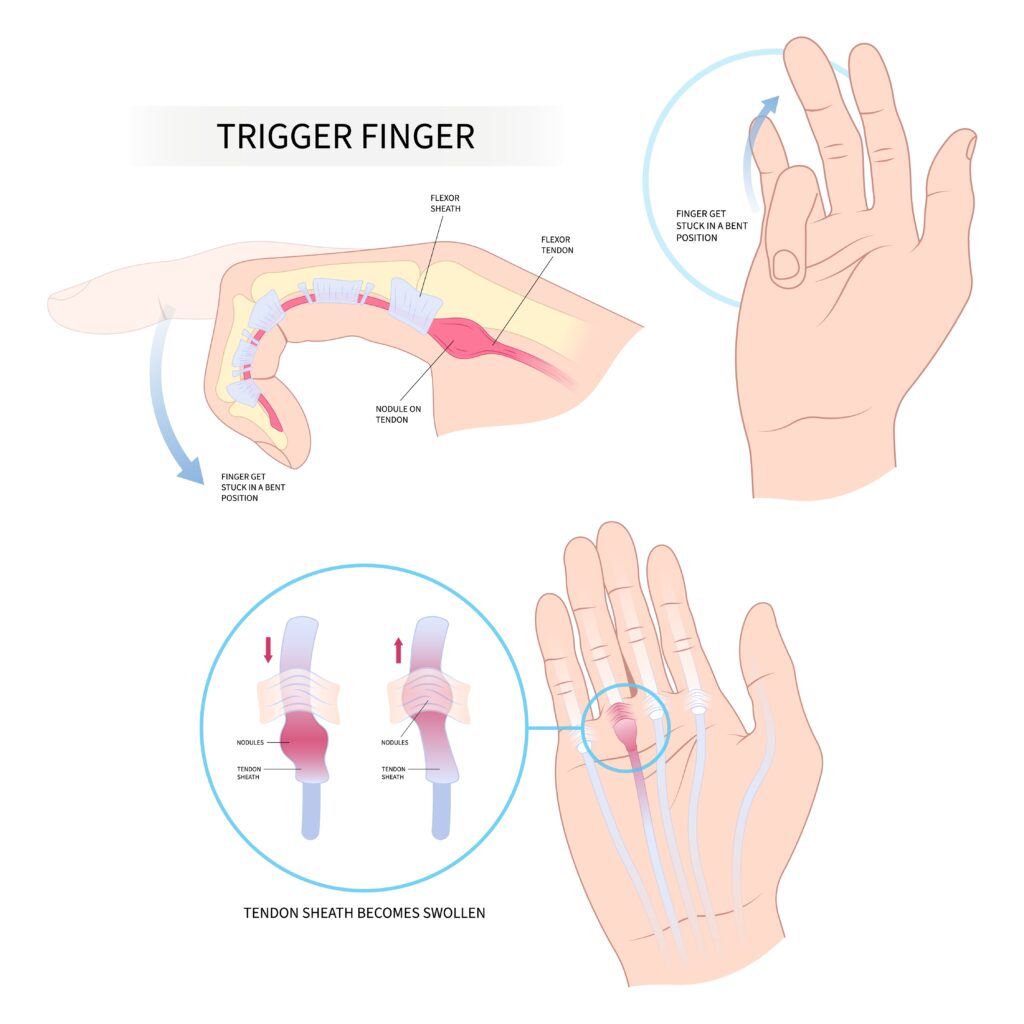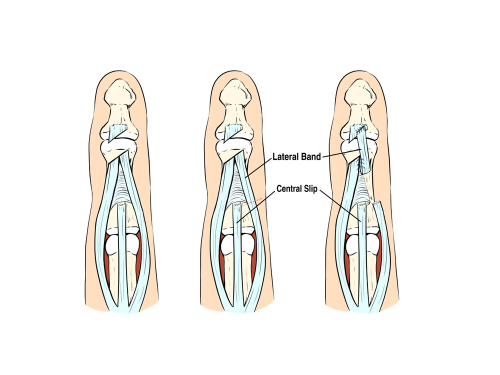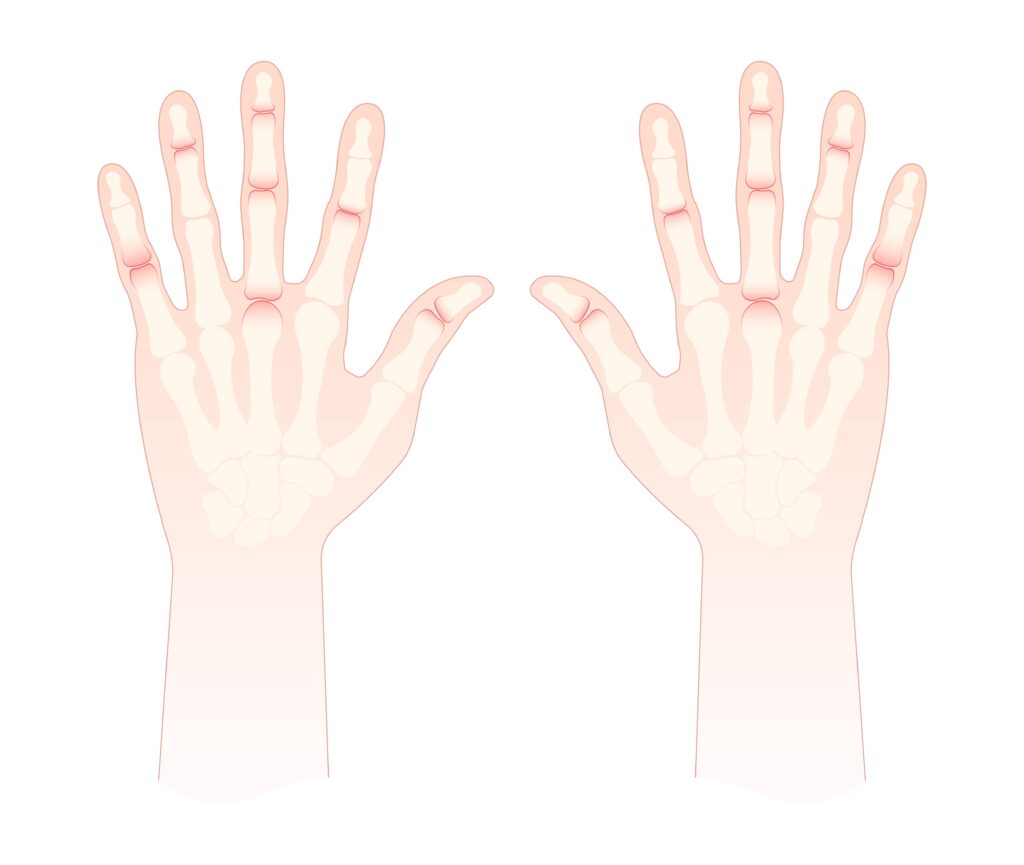鉴别诊断:扳机指 vs. 半脱位矢状带损伤 vs. 半脱位侧带损伤
Hand therapists frequently encounter patients presenting with finger pain, clicking, and difficulty with tendon glide. Among the most commonly confused conditions are 扳机 手指, 半脱位 sagittal band injury, and 半脱位 lateral band. Each of these pathologies involves different anatomical structures and biomechanical disruptions, but their overlapping clinical features can complicate accurate diagnosis. Understanding the subtle differences in presentation and performing targeted physical exams are crucial for appropriate treatment planning.
扣扳机的手指 or stenosing tenosynovitis, is a condition in which the flexor tendon becomes entrapped at the A1 pulley, typically due to thickening or inflammation of the tendon or pulley system. Patients often report a painful catching or locking sensation at the level of the metacarpophalangeal (MCP) joint, most commonly in the middle or ring fingers. On examination, passive flexion is typically smooth, but active extension may be met with resistance, followed by a sudden release, hence the “扳机” effect (Makkouk et al., 2008). Palpation often reveals a tender nodule at the volar MCP crease.

Subluxing Sagittal Band Injury, frequently referred to as “Boxer’s Knuckle,” occurs when the sagittal band fails to stabilize the extensor tendon over the MCP joint. This condition is most commonly seen in the long finger due to its increased excursion and susceptibility to trauma. Clinically, patients may report snapping or shifting of the extensor tendon during MCP flexion and extension. The hallmark physical exam finding is visible or palpable ulnar subluxation of the extensor tendon when the MCP is flexed and extended with resistance (Rayan & Young, 2006). Pain is typically localized dorsally over the MCP joint, and swelling may be present.

Subluxing Lateral Band injuries are less common and often occur in patients with connective tissue disorders (e.g., rheumatoid arthritis) or following trauma. The lateral bands, which contribute to PIP extension, may sublux volarly or dorsally due to rupture or laxity in the transverse retinacular ligaments. When subluxed volarly, the lateral bands may act as flexors of the PIP joint rather than extensors, mimicking boutonnière deformity. On exam, therapists may notice PIP flexion with DIP hyperextension and observe lateral band movement on active PIP flexion/extension. Palpation may detect band instability during resisted PIP movements (Harris & Rutledge, 2016).

These conditions are often confused because they can all present with clicking, pain near the MCP joint, and dysfunction during tendon excursion. For example, a 半脱位 sagittal band may mimic 扳机 finger in early stages when the tendon displacement causes a catching sensation. Similarly, 半脱位 lateral bands may be mistaken for sagittal band pathology if dorsal pain and snapping are present but not properly localized. Without a thorough assessment, these conditions may be misdiagnosed, leading to suboptimal treatment outcomes.
To differentiate them, location and direction of tendon displacement during resisted movement are key. Trigger finger will always involve the flexor tendon system and is palpable volarly, while sagittal band injuries produce dorsal instability at the MCP, and lateral band subluxation affects the PIP joint mechanics. Provocative testing, such as resisting MCP extension (for sagittal band), active PIP flexion (for lateral band), or palpation at the A1 pulley during finger motion (for trigger finger) can help isolate the pathology.
Accurate diagnosis also requires considering the patient’s history. Sagittal band injuries often follow a punch or hyperextension trauma, while 扳机 finger is usually atraumatic and related to overuse or inflammatory conditions. Lateral band instability may be tied to systemic illness or chronic joint stress. Imaging, including dynamic ultrasound, can further assist when diagnosis remains unclear.
In summary, although 扳机 finger, 半脱位 sagittal band injury, and 半脱位 lateral band may all present with similar symptoms, understanding their anatomical basis and performing focused physical exams allow for accurate differentiation. Early recognition is critical to guide conservative or surgical intervention and ensure optimal functional recovery.
参考
Harris, A., & Rutledge, C. (2016). Hand injuries: A practical guide to diagnosis and management. Springer.
Makkouk, A. H., Oetgen, M. E., Swigart, C. R., & Dodds, S. D. (2008). Trigger finger: Etiology, evaluation, and treatment. Current Reviews in Musculoskeletal Medicine, 1(2), 92–96. https://doi.org/10.1007/s12178-008-9012-1
Rayan, G. M., & Young, B. T. (2006). Boxer’s knuckle: Diagnosis and treatment. The Journal of Hand Surgery, 31(8), 1383–1388. https://doi.org/10.1016/j.jhsa.2006.05.009
Wolf, J. M., & Delaronde, S. (2009). Dynamic ultrasound evaluation of sagittal band injuries. Journal of Hand Surgery, 34(4), 712–715. https://doi.org/10.1016/j.jhsa.2009.01.007
更多阅读内容
手外伤患者发生复杂区域疼痛综合征 (CRPS) 的危险因素
参加手部治疗的患者的手部创伤和 CRPS 作者:Tristany Hightower Savaş, S.、 Ánal, EE、Yavuz, DD、Uslusoy, F.、Altuntaş, SH 和 Aydın, MA (2018)。接受手部治疗的手术治疗外伤患者发生复杂区域疼痛综合征的危险因素。手部治疗杂志,31(2), 250–254。 https://doi.org/10.1016/j.jht.2017.03.007…
阅读更多什么是慢性劳损性筋膜间隔室综合征?概述及手部治疗方案
筋膜室综合征是一种以体内某个筋膜室压力增高为特征的疾病,导致疼痛、肿胀和组织灌注减少 (Barkay 等人,2021;Buerba 等人,2019)。该综合征可分为急性和慢性 (Barkay 等人,2021)。慢性劳累性筋膜室综合征 (CECS) 是一种罕见类型,最常见于……
阅读更多一项前瞻性随机试验,比较第五掌骨颈骨折患者的 Buddy Taping 与闭合复位和石膏固定的功能结果
作者:Rachel Reed Martínez-Catalán, N.、Pajares, S.、Llanos, L.、Mahillo, I. 和 Calvo, E. (2020)。一项前瞻性随机试验,比较第五掌骨颈骨折患者的 Buddy Taping 与闭合复位和石膏固定的功能结果。手外科杂志,S0363-5023(20)30280-X。提前在线出版。 https://doi.org/10.1016/j.jhsa.2020.05.013 瘦子:这个随机的目的......
阅读更多注册即可直接将更新发送到您的收件箱!
注册我们,我们将定期向您发送有关手部治疗的所有内容的博客文章、每次上传新视频和教程时的通知,以及讲义、协议和其他有用信息。





